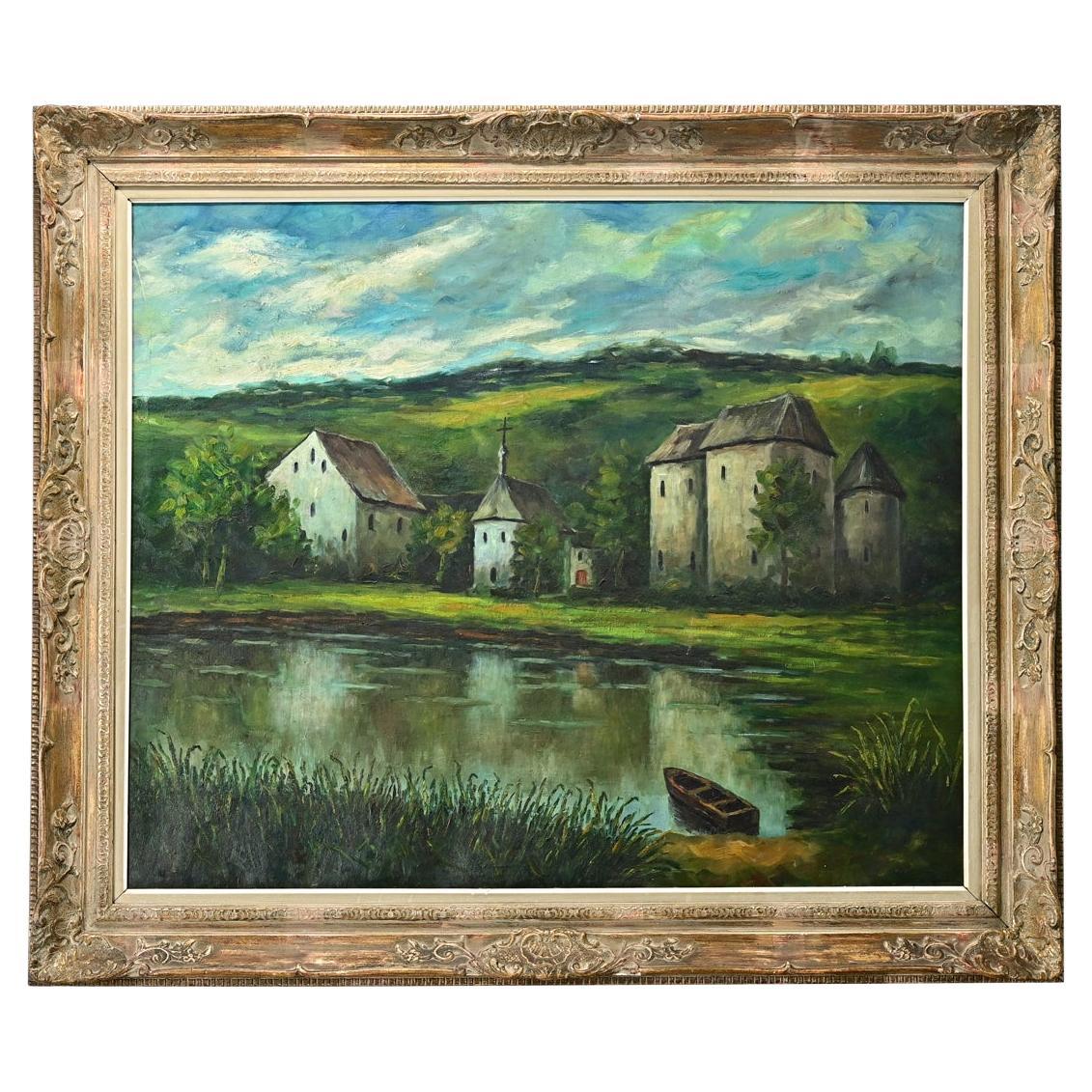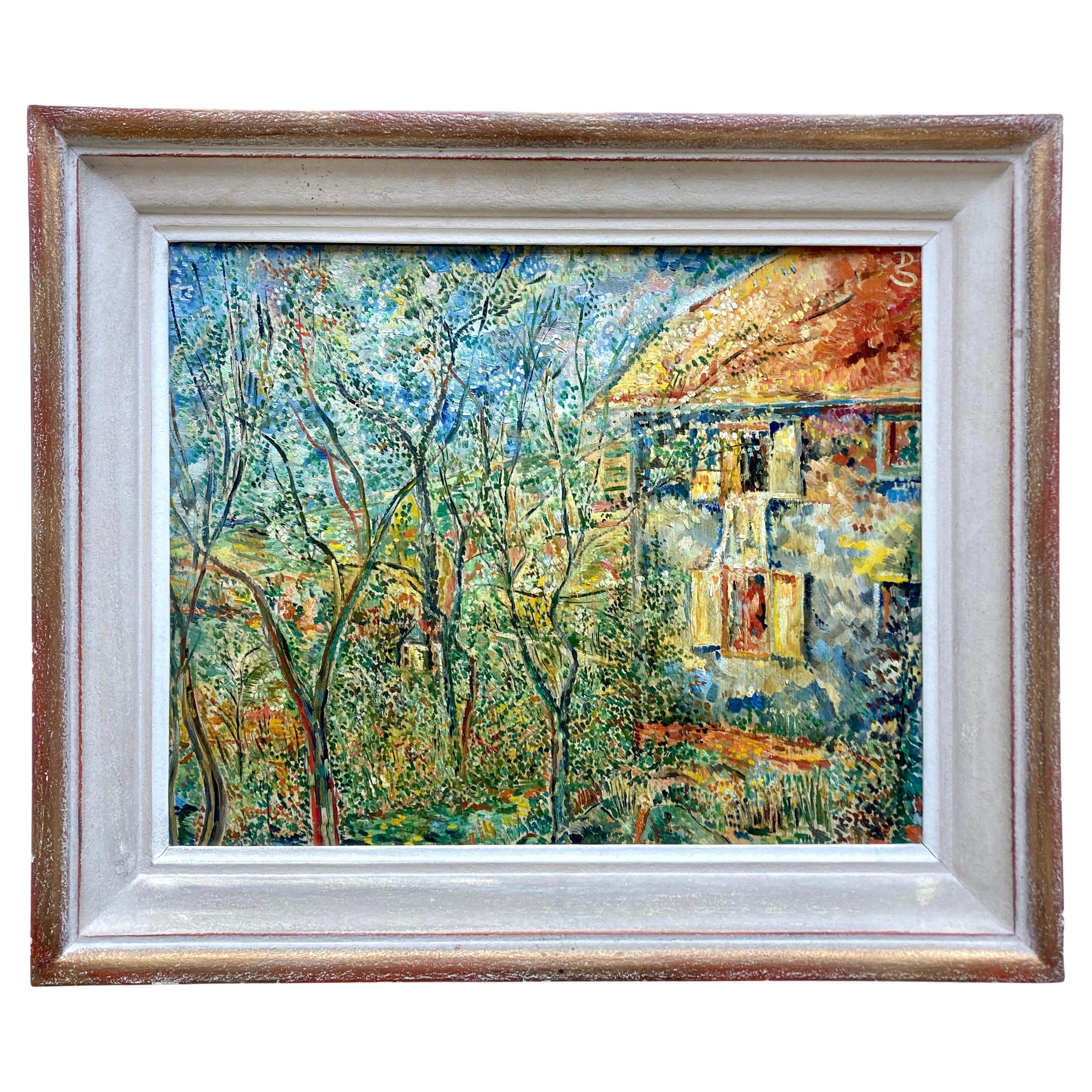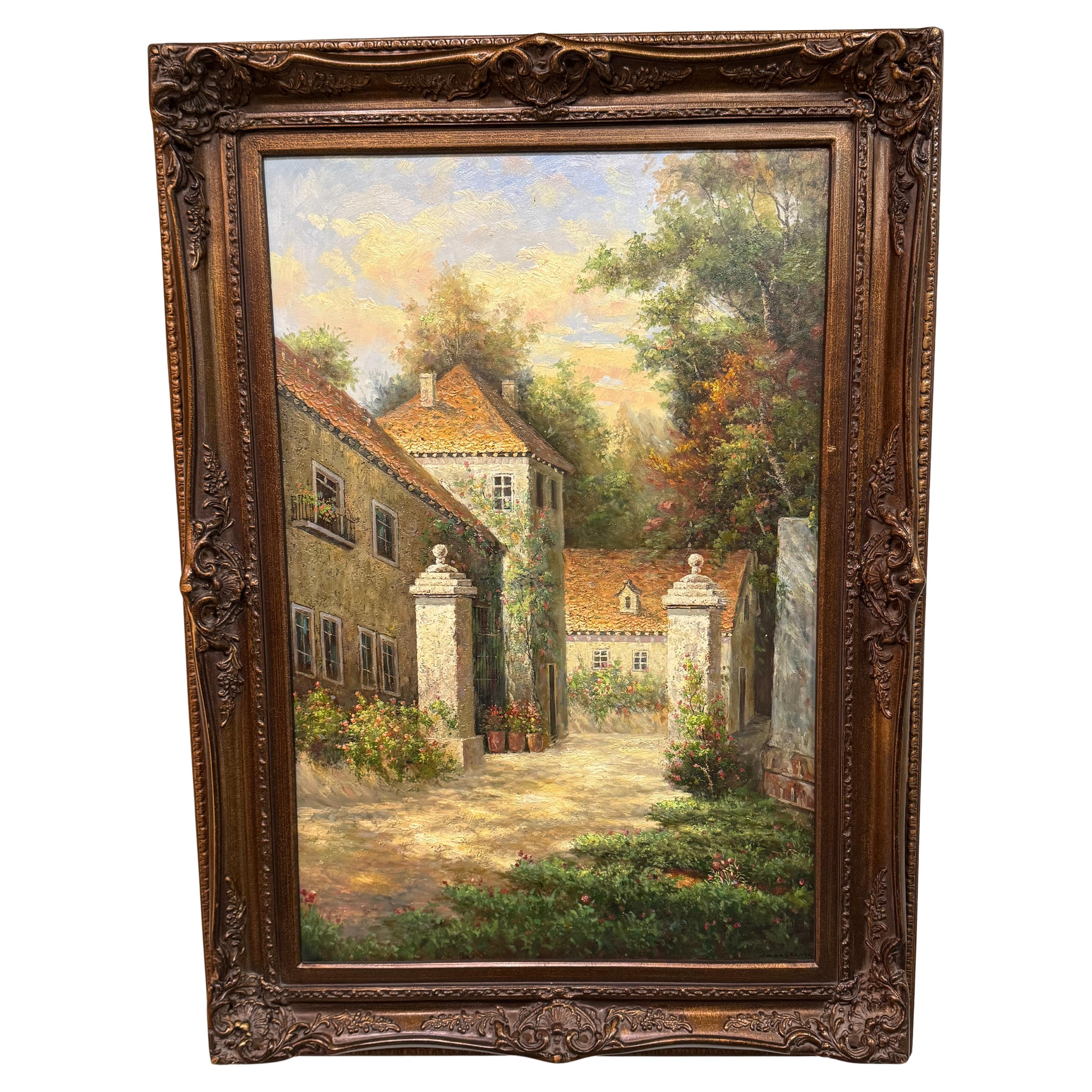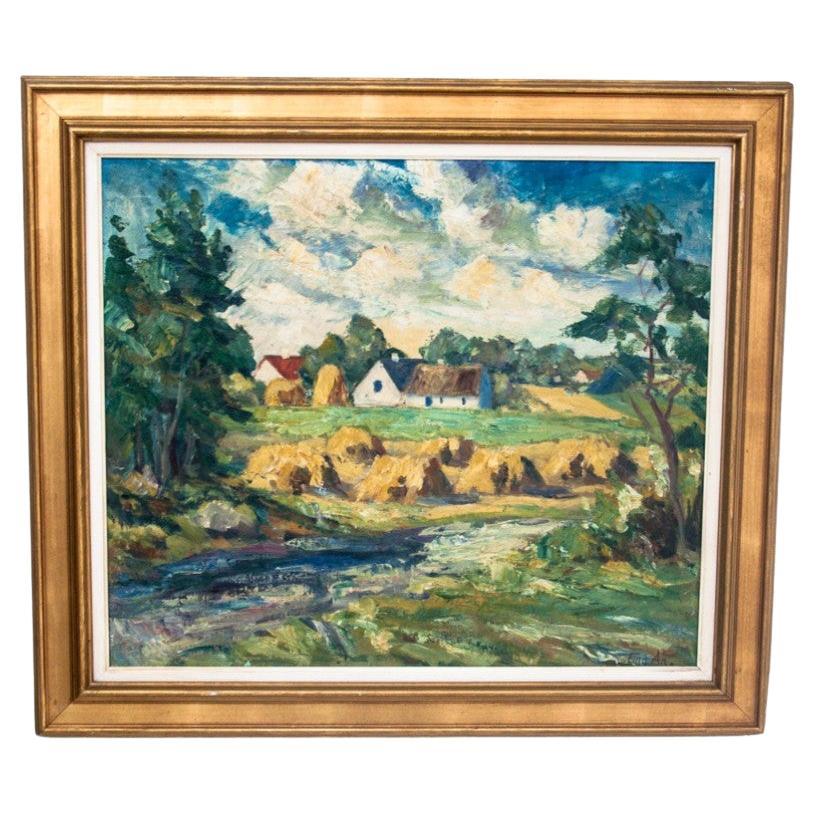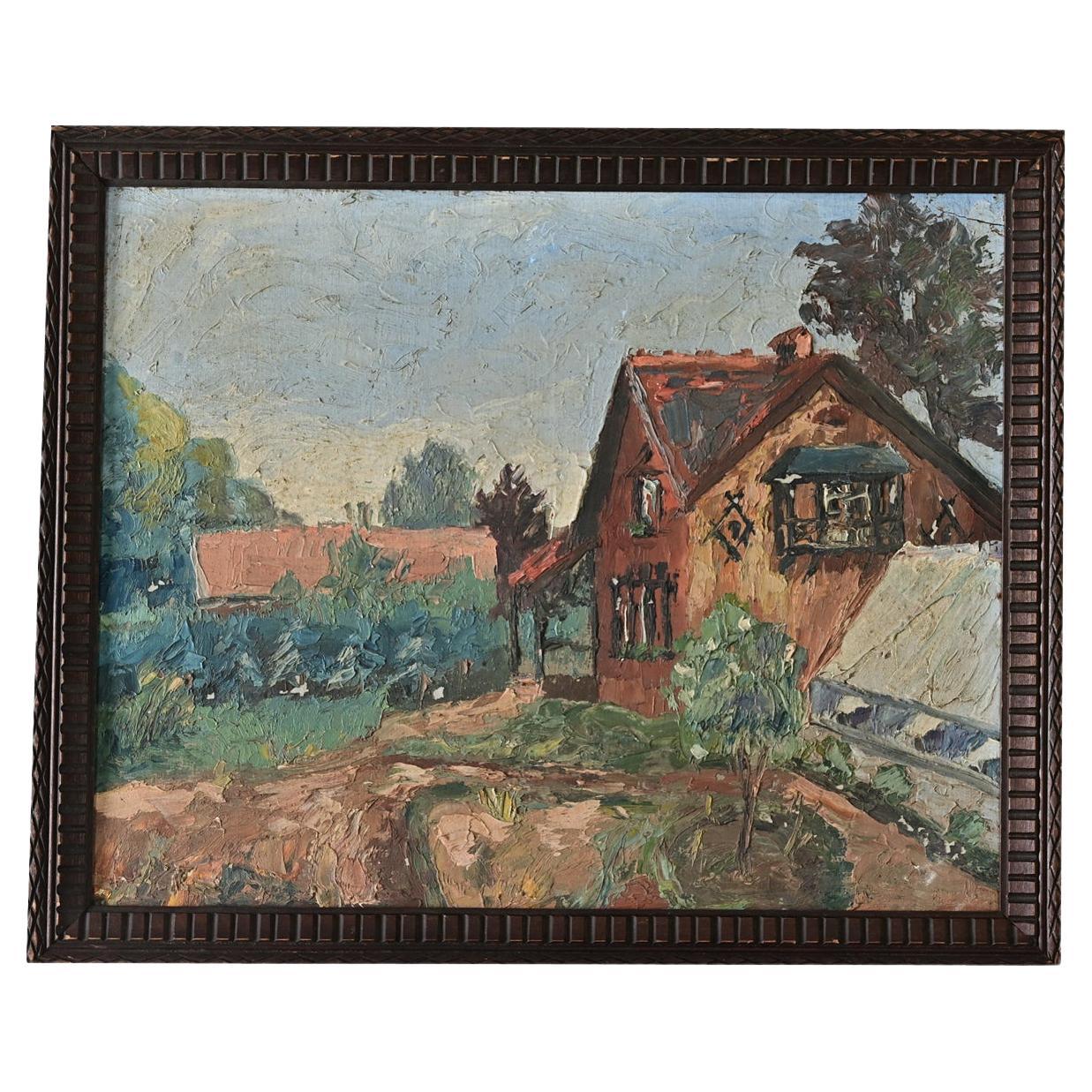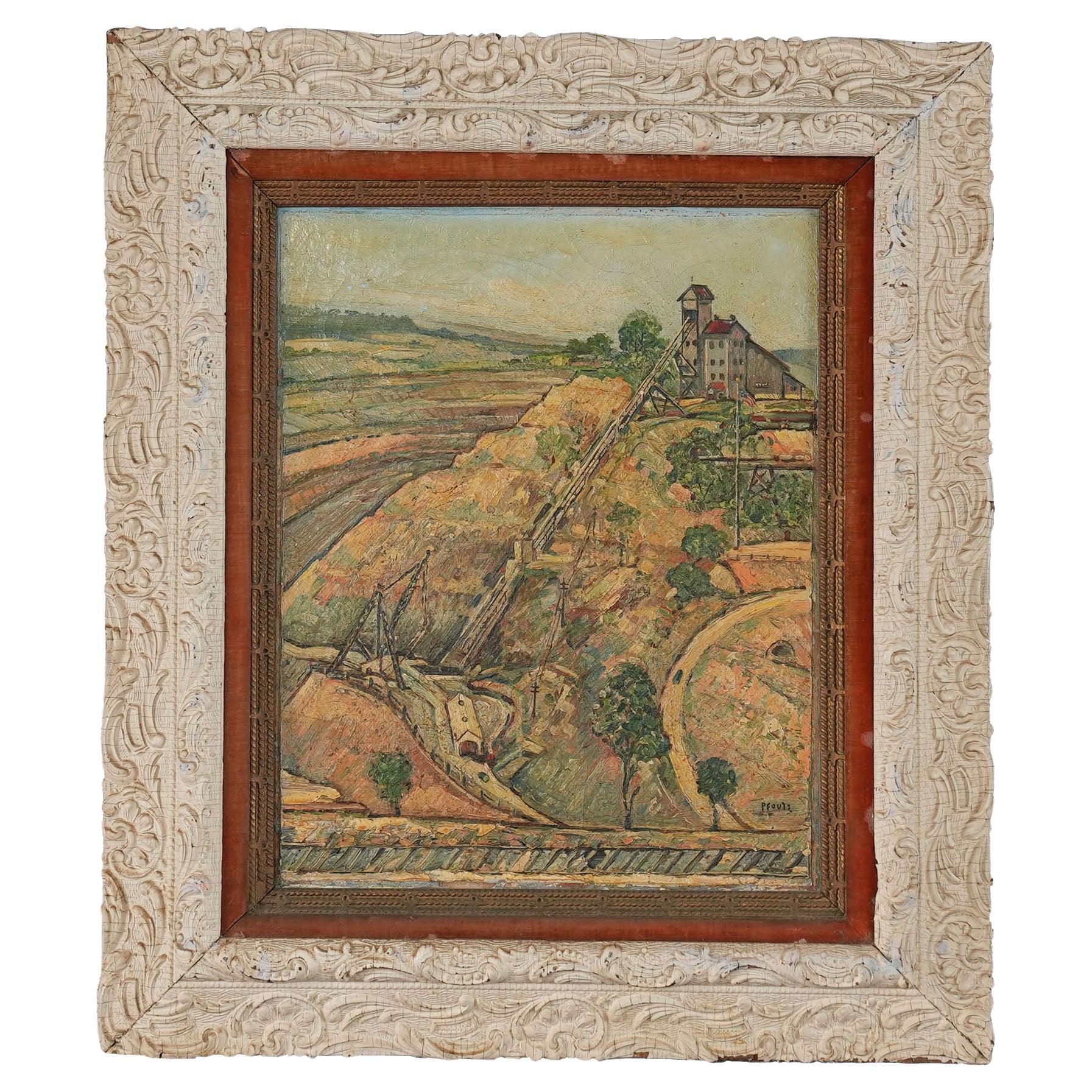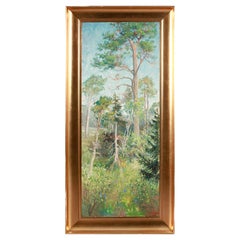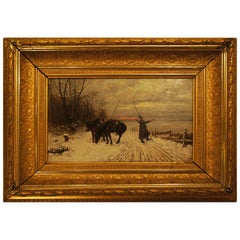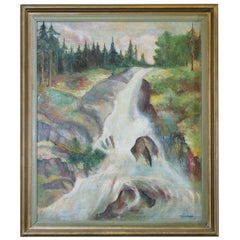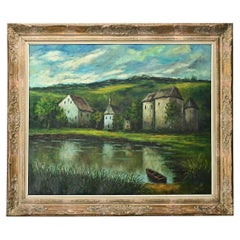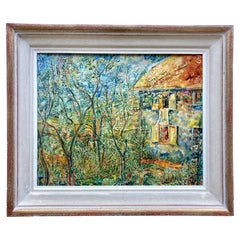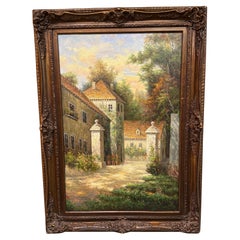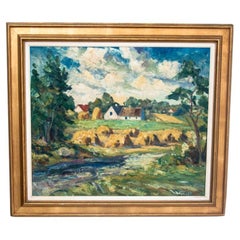Items Similar to Impressionist Style Country Chateau Scene
Want more images or videos?
Request additional images or videos from the seller
1 of 6
Impressionist Style Country Chateau Scene
$500
£377
€434.44
CA$693.64
A$777.21
CHF 404.57
MX$9,508.02
NOK 5,135.26
SEK 4,850.20
DKK 3,243.20
Shipping
Retrieving quote...The 1stDibs Promise:
Authenticity Guarantee,
Money-Back Guarantee,
24-Hour Cancellation
About the Item
Provence is a geographical region and historical province of Southeastern France, which extends from the left bank of the lower Rhône River to the west to the Italian border to the east, and is bordered by the Mediterranean Sea to the South. French Provence was the creative melting pot between the last quarter of the 19th century and the first of the 20th century, as Impressionism was gaining popularity. Drawn to its natural beauty, Provence was a perfect location for artists to develop their craft in this style. In this painting, one can see the artist's emphasis on the depiction of light in its changing qualities, as well as, elements of human perception and experiences. This piece conjures the timeless, relaxed atmosphere of Southern France. Unknown artist, unsigned. Measures: 31.5" W x 23.5" H.
- Dimensions:Height: 23.5 in (59.69 cm)Width: 31.5 in (80.01 cm)Depth: 2 in (5.08 cm)
- Style:Other (In the Style Of)
- Materials and Techniques:
- Place of Origin:
- Period:
- Date of Manufacture:circa 1950
- Condition:Wear consistent with age and use.
- Seller Location:New York, NY
- Reference Number:Seller: 1671stDibs: LU92946801703
About the Seller
4.7
Vetted Professional Seller
Every seller passes strict standards for authenticity and reliability
Established in 1983
1stDibs seller since 2012
210 sales on 1stDibs
Typical response time: 7 hours
- ShippingRetrieving quote...Shipping from: New York, NY
- Return Policy
Authenticity Guarantee
In the unlikely event there’s an issue with an item’s authenticity, contact us within 1 year for a full refund. DetailsMoney-Back Guarantee
If your item is not as described, is damaged in transit, or does not arrive, contact us within 7 days for a full refund. Details24-Hour Cancellation
You have a 24-hour grace period in which to reconsider your purchase, with no questions asked.Vetted Professional Sellers
Our world-class sellers must adhere to strict standards for service and quality, maintaining the integrity of our listings.Price-Match Guarantee
If you find that a seller listed the same item for a lower price elsewhere, we’ll match it.Trusted Global Delivery
Our best-in-class carrier network provides specialized shipping options worldwide, including custom delivery.More From This Seller
View AllÄlg, Otto Jansson. Post-Impressionist Landscape Study, Oil on Canvas, Signed
Located in New York, NY
Otto Jansson (1852 - 1903) was active/lived in Germany and Sweden. Otto Jansson is known for portrait and landscape painting.
Oil on canvas depicting a elk in a Swedish Forest. Wel...
Category
Antique Late 19th Century Swedish Paintings
Materials
Canvas, Giltwood
Russian Landscape
By H. Max
Located in New York, NY
A winter scene, depicting two Russian soldiers resting at sunset with their horses on a snow covered, well tracked road.
Category
Antique 19th Century Paintings
Materials
Canvas
$3,500
Swedish Landscape, Painting
By T. Lorentzson
Located in New York, NY
More peaceful than a feng shui fountain, this post-impressionist oil on canvas shows a stunningly normal scene from the Swedish forest. Stands of linden trees, fir and aspen frame a ...
Category
Vintage 1940s Swedish Paintings
Materials
Canvas
"Scandinavian Seascape, " Painting
Located in New York, NY
Another piece of every man's Nordic heritage: a fisherman and his wife, earning their living on the sea. Masts capture the gusts, propelling the pair forward on their journey, nets a...
Category
Vintage 1940s Swedish Paintings
Materials
Canvas
Swedish Seascape
Located in New York, NY
Göteborg, on Sweden's west coast, is a seafaring town, home to Volvo and SKF, is the powerhouse of Swedish industry. This oil painting on canvas, signed by Ivar Berg depicts Eriksber...
Category
Vintage 1950s Swedish Industrial Paintings
Materials
Canvas
$475
Nautical Oil Painting
By Hugo Josephsson
Located in New York, NY
An oil on canvas painting depicting a pair of sailors enjoying the morning marine layer of the North Sea, off the West Coast of Sweden.
Category
Early 20th Century Swedish Paintings
Materials
Canvas, Giltwood
$2,500
You May Also Like
Large French Framed Pastoral Scene Painting
Located in Baton Rouge, LA
A quality French oil on canvas painting of a pastoral scene. The painting depicts a church on a lake with vibrant and realistic colors, surrounded by a complimentary carved and gilt ...
Category
Antique 19th Century French Other Paintings
Materials
Canvas, Giltwood, Paint
Vintage Original Neo-Impressionist Oil Painting from France Signed by Artist
Located in COLMAR, FR
A colorful and striking piece of original art, undated but most likely from around the 1940s. This oil painting on wood-board has been sourced in France. The painting is signed by th...
Category
Mid-20th Century French Modern Paintings
Materials
Wood, Paint
Original impressionist courtyard landscape painting
Located in Birmingham, AL
depicts an impressionist courtyard landscape oil painting, Key features include:
Style: Impressionistic, characterized by soft edges and a focus on light and color.
Setting: A Eur...
Category
Early 20th Century American Paintings
Materials
Canvas
Painting "Rural landscape", Denmark, early XX century
Located in Chorzów, PL
Painting "Rural landscape".
Origin : Denmark, early XX century
Paintor : unknown
Dimensions:
Frame: height 71 cm / width 81 cm
Image: height 55 cm / width 64 cm
Category
Vintage 1930s Scandinavian Other Paintings
Materials
Canvas
$383 Sale Price
20% Off
French Vintage Framed Painting of a Homestead
Located in Baton Rouge, LA
This French vintage oil on board painting illustrates a peaceful moment at a modest homestead in rustic landscape. The vintage carved wood frame emphasizes the architectural and deco...
Category
20th Century French Other Paintings
Materials
Paint
Pfoutz Original Farm Scene Oil Painting
Located in Annville, PA
A very interesting and unusual Pfoutz Original Farm Scene Oil Painting by artist J. Earle Pfoutz. The painting is produced on artist and comes complete with what appears to be an original artist decorated/painted frame. The Pfoutz Original Farm Scene Oil Painting is signed on the front by the artist and appears to be dated 1948 on the rear. Known for his unusual subjects Pfoutz outdid himself with this effort, capturing the essence of a Lancaster County farm but with the startling twist of portraying a large turkey vulture in the foreground. Definitely unique.
Overall frame Size approximately 33″ wide x 3″ deep x 26″ high
J. Earle Pfoutz had a long and distinguished career as a self trained artist. More can be learned about him from reading this article produced by Gary Hawbaker at askART
Earle Pfoutz Born: 1891 – Lancaster, Pennsylvania
Died: 1957
Known for: Landscape, figure, still life painting
An image of J Earle Pfoutz
Biography from the Archives of askART
J. Earle Pfoutz (John Earle Pfoutz) – (Oct 23, 1891-Nov 9, 1957)
“A seventh generation descendant of a Swiss family which arrived in America early in the 17th Century, J. Earle Pfoutz was born in Lancaster, PA, son of John Bachman and Susan Allison Pfoutz. He painted houses for a living and pictures for a life.
A self-taught artist, described as a primitive, he was distinctive for his vivid imagination and bold color application. He painted hundreds of Lancaster County scenes. Pfoutz traveled through the hills near his home and along the Susquehanna River in search of scenes. He began painting with a brush when he was fourteen, but added a palette knife after suffering an eye injury. He completed eighth grade in the Lancaster Public Schools and there his formal education ended. However, the Department of Public Instruction of the State of Pennsylvania thought so highly of his work as an artist that officials certified him as an art instructor and he taught for a year in the York (PA) public schools. He also was an art instructor under the program for disabled veterans, sponsored by the Veterans Administration, when he gave private instruction to veterans in their homes.
In 1947, J. Earle Pfoutz finally earned national recognition as an artist. His painting, Opalescent October, was chosen by the Museum of Art of Dayton Ohio, to travel all over the country for a year with its Group Exhibition. Described as a “very colorful, calm scene, iridescent in color, sweeping in design,” the painting started on its journey around the country early in 1948. In an interview with the Sunday News (Lancaster, PA – Nov 2, 1947), Pfoutz stated that he didn’t know whether he was a “primitive” or an “impressionist.” No master taught him, no school channeled his style. “Sometimes I didn’t eat, but I always managed to paint,” he recalled. Many of his hundreds of canvases -most of them not sold, but given away to friends – found their way to other parts of the country. “I never remember the day when I did not love color,” Pfoutz said. “I was about 12 years old when I saw my first palette – a string of different colored paint paddles that graced the stores of that day. As a boy I had two great desires. One was to be able to eat all the strawberry jam I could, and the other to possess a string of those beautiful paint paddles. Well, I’ve got my fill of jelly, but I’ve never yet got my fill of beautiful colors.”
In 1950, Pfoutz’s one man show of paintings made front page headlines in the Lancaster Intelligencer Journal: “Most of the twenty oil paintings on exhibition are landscapes, although there are several interesting figure studies. Colors again, as in all Pfoutziana are rich and full-bodied, but for the most part not as startlingly as in some of the earlier work. Most of the paintings were done during the past year, and also reveal the painter’s characteristic heavy impasto technique, in which the rich swirls of paint carry their own message. Among the figures, The Banjo Picker, and The Magician, are the most provocative. Both are character studies; the first being of a tramp musician whose drab clothing is set-off by a luminous aqua blue background. Modern in feeling and treatment is The Magician, a clown-faced wizard whose spinning ball in the air suggests the fourth dimension – space. The use of the primary colors in this picture serves to emphasize the theme effectively.
A large colorful landscape, Opalescent October, depicting rolling hills against a late afternoon sky is new to Lancastrians, as it has just returned from Dayton, Ohio, where it hung in the Dayton Art Institute. Another landscape with soft dreamy colors is Fantasie D’Autumne, and one of the loveliest pictures in the show. Pennsylvania Dutch Country is another with eye appeal, and was one of the works which was hung in the Old Customs House in Philadelphia during Pennsylvania Week, and before that in a collection of Pfoutz work in the same place. In deep contrast to the sunny skies and brilliant foliage of many of the pictures, is the somewhat morbid Worry, in which the center of interest is a tremendous rat. This, the painter explains, was symbolic of 1948 in China, which was ‘The Year of The Rat’ in the Chinese calendar. Background material for the picture was furnished to Pfoutz by author Pearl Buck.
Other pictures include Autumn Prelude, Miners Village, painted at Cornwall, PA; Humid Day, Saint Peters Kierch, at Middletown, PA; Lady Pfoutz, inspired by the painter’s wife; Sun Flowers, Sentimental Journey, Gyne, Luzon Woman, Old Bridge, The Cow Path. Lemures, based on Roman mythology, and Ethiopian, painted from an ebony wood carving from Kenya Province, S. Africa.”
In 1953, Pfoutz was installed as President of the Lancaster County Art Association. A. Z. Kruse, New York City artist, writer and member of the faculty of the Brooklyn College and the Cartoonists and Illustrators School, Manhattan, was the guest speaker. In January of 1953, thirty-five Pfoutz oils were exhibited at the Old Custom House in Philadelphia, PA under the sponsorship of the Carl Schurz Memorial Foundation. Several Lancaster County landscapes and covered bridges were included as well as Katy, a Pennsylvania Dutch scene. Symbolic paintings included End of the Second Day, the artist’s visualization of the second coming of Christ, and Twilight, typifying the grief of mothers of all lands for sons lost in battle.
In June of 1953, a Pfoutz oil made history in Lancaster. From the Lancaster New Era: “For the first in local art history, a painting has been withdrawn from an exhibition because of objections from viewers and hostesses serving at the show. The painting, Jeune Fille, a standing nude done by Pfoutz, was one of the paintings in the annual spring exhibition of the Art Association and had become the center of the controversy. Pfoutz said he took the painting down… ‘graciously but reluctantly.’ ‘From an artistic standpoint, there is nothing offensive about the painting,’ Pfoutz said. ‘This community just wants its nudes with clothes on.’ “It is most brilliant in color, and because it is so brilliant I thought it would make a nice lively spot for the show. This is the first time I’ve had to take a picture off the walls. I substituted a seascape for it.’ Pfoutz said he felt the painting brought a lot of viewers to the show because it was so controversial. It had never been exhibited before. ‘If this had been shown in a metropolitan city,’ he commented, ‘people wouldn’t have given it a second glance. But the viewpoint here is more conservative, even though I don’t think moderns would have minded.’ He said he felt the painting was neither ‘objectionable nor pornographic,’ but had complied with the wishes of fellow members of the Art Association who telephoned him to relay the protests they had received. The art controversy was the first to arise here publicly since the showing of Amish Grandmother, an oil by William Gropper which was part of the Gimbel Pennsylvania exhibit at the Griest Building several years ago. — Numerous viewers of Amish Grandmother, [a painting showing an Amish woman holding a white goose], expressed themselves quite vocally, calling it an affront to the Plain Folk. But it stayed on exhibit throughout the length of the Gimbel show. Pfoutz expressed no rancor, implying that if Gropper could take it so could he.”
After his death, there were several shows of Pfoutz’ work organized by his son J. Earle, Jr. J. Earle, Jr. also saw to it that President Eisenhower would receive an oil called The Cow’s Path. The president first saw the painting in 1950 when, as president of Columbia University, he visited Lancaster to address a student assembly at Franklin and Marshall College. After his address was over, the then Gen. Eisenhower stopped at the Fackenthal Library on the campus to view an exhibition of Pfoutz’s paintings. The Cow’s Path intrigued him. For some time, as his aides fumed to get him back on his time schedule, Eisenhower and Pfoutz talked, as artist to artist. Prior to his death, Pfoutz requested that The Cow’s Path be given to the President if he wanted it. The painting was presented to Ike at the White House in November of 1959. Mrs. Eisenhower owned a Pfoutz painting titled, In the Manor.
Though house painting was his livelihood, he worked for Millersville State Teachers College (now a university) for a time during World War II, and called himself “the Chimney Sweep of MSTC.” During that period he knocked out a dizzying canvas in the surrealist style (he thought it was terrible) and got into the campus newspaper when one of the students spotted it.
Earle Pfoutz was not the humble, downtrodden artist, not the Douanier Rousseau type at all. As he developed his skill and style through the years, he also fashioned a resilient confidence in himself as an artist. Whether he was building his own home (he built two) or painting one for somebody else, he never lost faith in his ultimate recognition—though he was never sure he would live to see it.
Whether he was working as a rigger for a hoisting company, in the Stehli Silk Mill of Lancaster, carving Cloister-style chairs, decorating old chests, cementing bricks from the old Safe...
Category
Vintage 1940s American Paintings
Materials
Paint
More Ways To Browse
Antique English Delftware
Antique Mexican Textiles
Antique Russian Clock
Antique Russian Clocks
Antique Spanish Clocks
Antique Swedish Trunk
Antique Victorian Bonnet
Art Deco Auto
Art Deco Pendulum
Asian Water Jar
Avon Antique
Baker Campaign
Baker Furniture Campaign
Baker Furniture China
Bar Hutch
Baroque Secretary
Bed 160 X 200
Birds Eye Maple Chest
